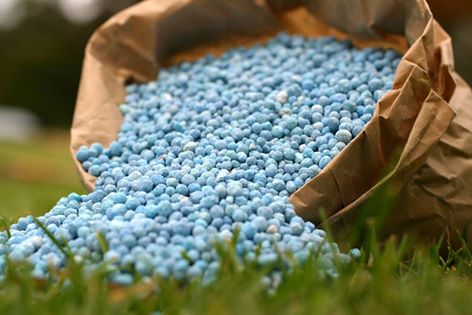- Categories:
- Fertilizer
- Maintenance
- Landscaping

While all aspects of your routine are important, your fertilizer application is what has the most effect on your turf and plants. Landscapes are living organisms that require three things for them to survive: water, food and oxygen. Fertilizer supplies the food your plants need for a healthier look.
We all know what fertilizer is, but really, what is it? Fertilizer supplies plants nutrients they need that aren’t readily available from the soil. There are 16 essential elements that are responsible for plant growth. Some elements are supplied by Mother Nature: OXYGEN, CARBON and HYDROGEN. Fertilizer mostly consists of the elements (macronutrients) that provide a growth response: NITROGEN, PHOSPHORUS and POTASSIUM. Together these macronutrients provide the primary nutrition by plants required for growth. Then finally micronutrients are added to the product, which include the other 10 elements that are needed in lower amounts. These micronutrients help with internal processes that support plant growth and plant health.
Types of Fertilizer
There are many types of fertilizer out there to support plant growth:
- Quick release nitrogen fertilizer – quick green up requiring more applications each season (every 4-6 weeks)
- Slow release or controlled release nitrogen fertilizer – nitrogen is released over time, extending the feeding period to the plant (lasts 8 – 24 weeks, depending on product)
- Organic fertilizer - contributes to soil fertility by providing nutrient energy to the microbes in the soil
While all these products do provide food to the plant, not all of them contribute to soil fertility.
So how do I know which one to choose? Start with what you are growing and how you want it to grow. Turf foods and ornamental plant foods usually differ in their ingredients and how they work. For ornamentals, it’s not economical to be fertilizing monthly so a balanced ratio (i.e., 15-15-15) with a slow release nitrogen is your best choice. For turfgrass, if you want a quick response, use a water soluble quick release nitrogen product. But with that you get consequences like fast growth, high yield, thatch buildup, root deterioration, and frequent applications. Instead I recommend using a slow release product that extends the feed and limits most of these liabilities. Not only is this type of nitrogen release healthier for the plant, it reduces labor costs through less applications. Finally, consider the release characteristics of the fertilizer. You don’t want to use a product in the heat of the summer that releases with heat and water or use an organic in the early spring when soils are still cold.
It’s so easy to get caught up in the cost per bag when selecting a fertilizer. But if you really want to maximize your profitability you need to be looking at cost per application or per season. Sure, that quick release may be a few dollars cheaper but you will have to apply it 2 – 3 times more often for the same results as the higher quality slow release fertilizer. Factor in labor costs, and you can see the better choice is often the slow release. Your local Horizon professional can help you make the right choice for your application.